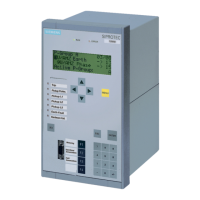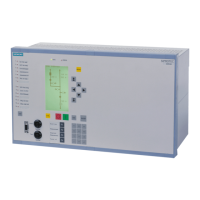Delay times
When the initiatiation conditions are fulfilled, the associated timers are started. The circuit breaker pole(s)
must open before the associated time has elapsed.
Different delay times are possible for 1-pole and 3-pole initiation. An additional delay time can be used for
twostage circuit breaker failure protection.
With
single-stage circuit breaker failure protection, the trip command is relayed to the adjacent circuit breakers
which interrupt the fault current if the local feeder breaker fails (see Figure 2-31 and Figure 2-32). The adja-
cent circuit breakers are those located at the busbar or busbar section to which the feeder under consideration
is connected. The possible initiation conditions for the circuit breaker failure protection are those discussed
above. Depending on the application of the feeder protection, common phase or phase-segregated initiation
conditions may occur. The circuit breaker failure protection always trips 3-pole.
The simplest solution is to start the delay timer T2 (Figure 2-40). The phase-segregated initiation signals are
omitted if the feeder protection always trips 3-pole or if the circuit breaker is not capable of 1-pole tripping.
If different delay times are required after a 1-pole trip or 3-pole trip it is possible to use the timer stages
T1-3pole and T1-1pole according to Figure 2-41.
[logik-1-stufiger-svs-phgem-anwurf-wlk-010802, 1, en_GB]
Figure 2-40 Single-stage breaker failure protection with common phase initiation
[logik-1-stufiger-svs-unterscht-verz-t-wlk-010802, 1, en_GB]
Figure 2-41 Single-stage breaker failure protection with different delay times
With two-stage circuit breaker failure protection the trip command of the feeder protection is usually
repeated, after a first time stage, to the feeder circuit breaker, often via a second trip coil or set of trip coils, if
the circuit breaker has not responded to the original trip command. A second time stage monitors the
response to this repeated trip command and trips the circuit breakers of the relevant busbar section if the fault
has not yet been cleared after this second time.
For the first stage, a different delay T1-1pole can be set for 1-pole trip than for 3-pole trip by the feeder
protection. Additionally, you can select (by setting parameter 1p-RETRIP (T1)) whether this repeated trip
should be 1-pole or 3-pole. In case of a multi-pole tripping of the feeder protection, T1-1pole and T1-3pole
are started simultaneously. By means of T1-3pole, the tripping of the circuit breaker failure protection can
be accelerated in comparison to T1-1pole.
Address 3913 T2StartCriteria is used to set whether the delay time T2 will be started after expiry of T1
(T2StartCriteria = With exp. of T1) or simultaneously with it (T2StartCriteria = Parallel
withT1). The time T2 can also be initiated via a separate binary input 1424
>BF STARTonlyT2
.
Functions
2.6 Circuit breaker failure protection (optional)
122 SIPROTEC 4, 7VK61, Manual
C53000-G1176-C159-5, Edition 05.2018

